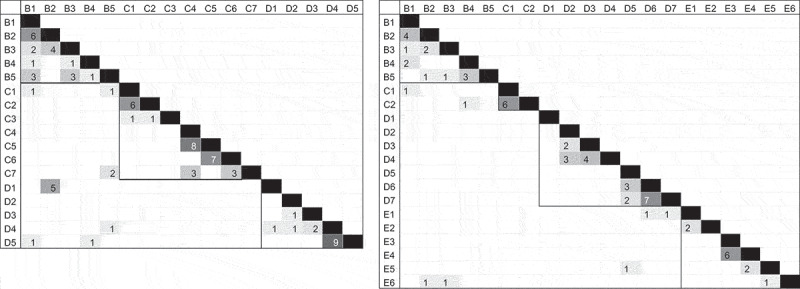Figure 3.

Number of networks finding edge-weights to be stronger than at least two-thirds of the total computed edge weights in network, DSM-IV (left), and DSM-5 (right).
Left panel: DSM-IV: B1: recurrent thoughts of trauma, B2: recurrent dreams of trauma, B3: flashbacks, B4: psychological cue reactivity, B5: physiological cue reactivity, C1: avoidance of thoughts of trauma, C2: avoidance of reminders of trauma, C3: memory impairment, C4: diminished interest in activities, C5: feelings of detachment from others, C6: restricted range of affect,C7: sense of foreshortened future, D1: sleeping difficulties, D2: irritability or anger, D3: difficulty concentrating, D4: hypervigilance, D5: exaggerated startle response, C6_2: Numbness sad/anger.Right panel: DSM-5: B1: recurrent thoughts of trauma, B2: recurrent dreams of trauma, B3: flashbacks, B4: psychological cue reactivity, B5: physiological cue reactivity, C1: avoidance of thoughts of trauma, C2: avoidance of reminders of trauma, D1: memory impairment, D2: negative beliefs, D3: distorted blame, D4: persistent negative emotional state, D5: diminished interested in activities, D6: feelings of detachment from others, D7: inability to experience positive emotions/restricted range of affect, E1: irritability or anger, E2: reckless/self-destructive behaviour, E3: hypervigilance, E4: exaggerated startle response, E5: difficulty concentrating, E6: sleeping difficulties.
